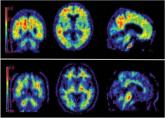News


A $100 million study may decide the financial fate of amyloid PET imaging and thus potentially the frequency with which it is used to help rule out Alzheimer’s disease as a cause of dementia.
If the study finds that amyloid imaging improves patient outcomes, hopes are high that Medicare may reverse a 2013 decision that severely limited reimbursement for the procedure and start covering the scan for patients being evaluated for cognitive decline or progressive dementia of unknown etiology.
Although Medicare officials said that extant data don’t confirm improved patient outcomes with amyloid PET imaging, they promised to revisit the issue should new information emerge. The IDEAS study is designed to provide that information, according to Maria C. Carrillo, Ph.D., chief science officer of the Alzheimer’s Association and a cochair of the study.
“One aim of the IDEAS study is to clearly demonstrate that an early and accurate Alzheimer’s disease diagnosis is aided by the use of brain amyloid PET scans – in appropriate cases where there is substantial diagnostic uncertainty. Also, we hope to show that this novel technology can improve health outcomes,” she said in an interview. “I am confident that, at the end of this study, we will have amassed sufficient data to assess whether amyloid imaging has a positive impact on patient outcomes leading to expansion of beneficiary access to this important procedure beyond the IDEAS study.”
The Alzheimer’s Association worked with the Centers for Medicare & Medicaid Services to design the trial, which is expected to cost about $100 million. CMS will pay for the PET scans – estimated at $80 million – under its Coverage with Evidence Development program. The rest of the money is expected to come from industry and philanthropic sources.
IDEAS has two goals: to examine how amyloid imaging might affect the clinical management of patients with symptoms suggestive of Alzheimer’s, and how it might affect 12-month major medical outcomes (such as hospitalization or emergency department admissions) for those patients, compared with a control group.
Positive findings could be used to support another plea for Medicare to cover the scans in clinical practice. Reimbursement is currently limited to one scan per patient, and only for those enrolled in an approved randomized clinical trial.
The root of CMS’ reluctance to full endorse amyloid scanning is its clinical utility – or lack thereof. The agency agreed that the procedure is useful for excluding Alzheimer’s in some clinically difficult diagnoses and that it is a very good tool for ensuring that amyloid-positive patients are actually being enrolled in studies. But, officials said, there is little extant evidence that being able to identify amyloid plaques in the brain of a cognitively impaired patient can do anything to alter the trajectory of illness, either clinically of financially. It’s never been linked to improvements in any clinical outcomes – either avoidance of expensive or futile testing, reduced hospitalizations, improved quality of life, or delay of disease progression. And since there are no disease-modifying therapies, amyloid imaging isn’t proven to contribute to treatment decisions.
IDEAS aims to fill in these knowledge gaps. It will enroll 18,488 Medicare beneficiaries aged 65 years and older, who have either a progressive, unexplained mild cognitive impairment, or dementia of unknown etiology. They will undergo one amyloid PET scan and be followed for 12 months.
The study will investigate both the short- and long-term impact of amyloid imaging on patient outcomes.
Aim 1 will examine how a scan might affect patient management in the first 90 days after the procedure, by comparing actual post-scan management to the pre-scan intended management. Outcomes here include the use of Alzheimer’s drugs, other medications, and counseling about safety and future planning.
Aim 2 will use Medicare claims data to compare 12-month medical outcomes between study subjects and matched controls. The primary objective here is to learn whether amyloid imaging is associated with any significant reductions in outcomes such as hospitalization and emergency department visits. Health resource utilization will also be examined.
Even if CMS broadens its reimbursement policy for amyloid scans, the procedure won’t be applicable for every patient, Dr. Carrillo said. But for those for whom it is appropriate, scan results will add valuable information to the diagnostic and planning picture.
“An early and accurate diagnosis is best for many reasons,” she said. “If a scan is positive, a clinician should be able to provide the patient and family with not only a care plan, but [also] referral to the Alzheimer’s Association, family planning for the future, and participation in clinical trials. A more accurate diagnosis can also ensure better care to manage a person’s other diseases and medications to ensure positive health outcomes and quality of life. If a scan is negative, a physician may then explore other reasons for the dementia symptoms which also lead to an accurate diagnosis and better care plans.”

